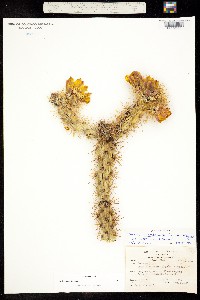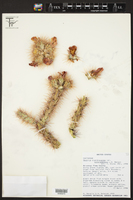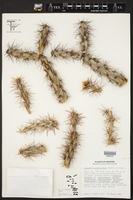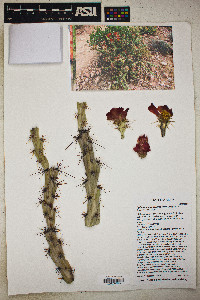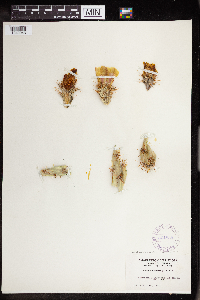Cylindropuntia acanthocarpa
|
|
|
|
Family: Cactaceae
Buck-Horn Cholla, more...buckhorn cholla (es: choya, tasajo)
[Opuntia acanthocarpa Engelm. & Bigelow, moreOpuntia acanthocarpa var. ramosa Peebles] |
Trees or shrubs, sparsely to densely branched, 1-2(-4) m. Stem segments firmly attached, cylindric, 10-30(-50) × 2-2.5(-3) cm; tubercles prominent, narrow to broad, 1.5-4.5 cm; areoles elliptic to subcircular, 4-5.5 × 4-5 mm; wool white or yellowish to tan, aging gray-black. Spines 6-20(-30+) per areole, often accompanied by 0-5 short bristlelike spines at areole margins, usually in distal areoles; major abaxial spines deflexed to divergent, subterete to flattened; major adaxial spines ascending-divergent, terete, yellow or tan to deep red-brown, aging gray, the central spine longest, 12-30(-38) mm; sheaths white to grayish with yellow to golden tips, baggy to tight fitting. Glochids in inconspicuous to small adaxial tuft, yellow to brown, 0.5-2 mm. Flowers: inner tepals bright yellow to bronze to brick red, spatulate, 20-30 mm, apiculate-emarginate; filaments red; anthers yellow; style and stigma lobes white to light green. Fruits tan at maturity, obconic to ellipsoid, 15-35 × 15-20 mm, dry, tuberculate, densely to sparsely spiny (rarely spineless), with apical flange above shallow umbilicus; basal tubercles longest; areoles 12-30. Seeds pale yellow to tan, angular or squarish in outline, warped, 3.5-5 × 3-4.5 mm, sides smooth, each with 2-4 large depressions; girdle smooth. Cylindropuntia acanthocarpa hybridizes with C. abyssi, C. echinocarpa (= C. ×deserta), C. bigelovii (= C. ×campii), C. leptocaulis (see C. ×tetracantha), C. ×multigeniculata, C. spinosior, C. versicolor, and C. whipplei (= C. congesta). Hybrids of C. acanthocarpa and C. ×multigeniculata are more open in habit, with longer stem segments than C. ×multigeniculata and with reddish filaments like C. acanthocarpa.
Plant: tree or shrub, sparsely to much-branched, 1-2(-4) m tall; STEM segments firmly attached, cylindric, 10-30 (-50) cm long, 2-2.5(-3) cm in diam.; tubercles prominent, narrow to broad, 1.5-4.5 cm long. AREOLES white-, yellowish- to tan-felty, aging gray-black, elliptic to subcircular, 4-5.5 mm long, 4-5 mm wide Leaves: SPINES mostly in distal areoles, 6-20(-30) per areole, often with 0-5 short bristle-spines at areole margins; sheaths white to grayish with yellow to golden tips, baggy to more tight-fitting; major apical spines terete, ascending-divergent, yellow or tan to deep red-brown, aging gray, the central one longest, 12-30(-38) mm long; major basal spines subterete to flattened, deflexed to divergent, the central one longest, 12-30(-35) mm long. GLOCHIDS yellow to brown, in inconspicuous small apical tuft, 0.5-2 mm long Flowers: inner tepals bright yellow to bronze to brick-red, spatulate, apiculate-emarginate, 2-3 cm long; filaments dark red, the anthers yellow; style and stigmas white to light green Fruit: at maturity tan, obconic to ellipsoid, the basal tubercles longest, dry, with apical flange above shallow umbilicus, 1.5-3.5 cm long, 1.5-2 cm in diam., densely to sparsely spiny, rarely spineless; areoles 12-30; SEEDS 3.5-5 mm long, 3-4.5 mm wide, pale yellow to tan, angular or squarish in outline, warped, the sides smooth but each with 2-4 large depressions, the girdle smooth REFERENCES: Pinkava, Donald J. 1999. Cactaceae. Ariz. - Nev. Acad. Sci. 32(1). Pinkava 1999, FNA 2003 Common Name: buck-horn cholla Duration: Perennial Protected Status: Salvage restriced status in Arizona. General: Small tree or shrub that is sparsely to much branched, 1-2 m tall with stem segments firmly attached, these cylindric 10-30 cm long and 2-2.5 cm in diameter, with prominent tubercles that range from narrow to broad, 1.5-4.5 cm long. Spines: Areoles white, yellowish, to tan, almost felty, aging gray black, elliptic to subcircular, 4-5.5 mm long, 4-5 mm wide. The spines in areoles toward the tips with 6-20 per areole, each with 0-5 short bristle spines at the areole margins, the apical spines are terete, yellow or tan. Flowers: Inner tepals bright yellow to bronze to brick red, spatulate, the small pointed tip notched 2-3 cm long, the filaments dark red and the anthers yellow with the style and stigmas white to light green. Fruits: Tan at maturity, obconic to ellipsoid with basal tubercles the longest, dry with apical flange above shallow umbilicus, 1.5-3.5 cm long, 1.5-2 cm in diameter, densely to sparsely spiny, rarely spineless, with 12-30 areoles. Ecology: Found on sandy flats to rocky slopes from 500-5,000 ft (152-1524 m), flowers March-June Distribution: sw UT, s NV to s CA, w AZ and Sonora, MEX. Notes: There are four varieties in Arizona: var. thornberi is told apart by its 25-45 mm long prominent tubercles, with gray green segments, and not or barely interlaced areoles; var. acanthocarpa told apart by the whitish to light brown spines 15-25 per areole and oval tubercles, var. coloradensis has branches mostly at acute angles, with yellowish green segments 15-30 cm long; var. major has branches mostly at obtuse angles with green to dark green segments, 8-20 cm and 14-18 spines per areole. Ethnobotany: Dry woody joints make handicrafts, stem ash was applied to burns or cuts, taken for stomach troubles, the fruits was gathered and eaten fresh or dried, pit roasted, and baked for food. Etymology: Cylindropuntia is from Greek kylindros or a cylinder, plus the genus Opuntia, while acanthocarpa means with thorny fruits like the genus Acanthus. Synonyms: Opuntia acanthocarpa Editor: SBuckley, 2010 |
|
|
|





























